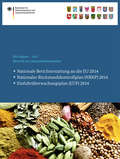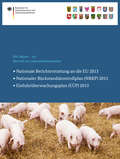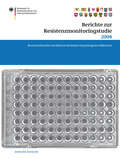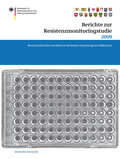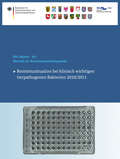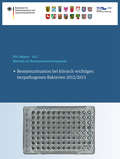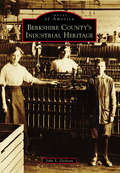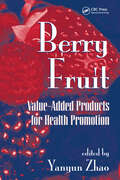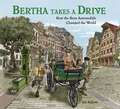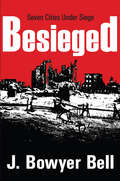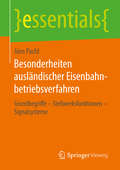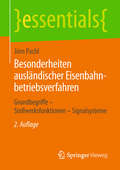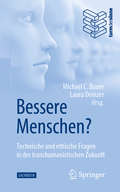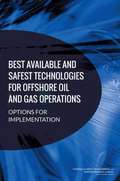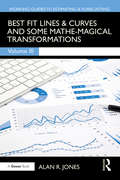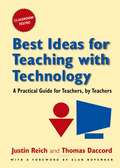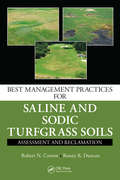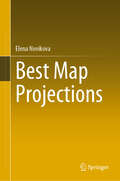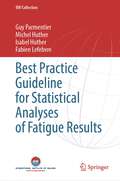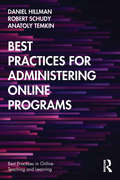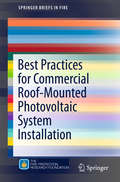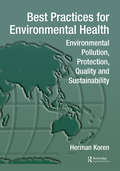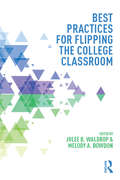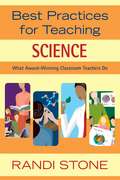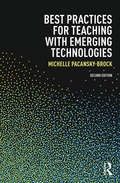- Table View
- List View
Berichte zur Lebensmittelsicherheit 2014: Nationale Berichterstattung an die EU, Nationaler Rückstandskontrollplan (NRKP), Einfuhrüberwachungsplan (EÜP) (BVL-Reporte #10.6)
by Bundesamt für Verbraucherschutz und LebeNationale Berichterstattung an die EU Berichte über (a) die Veterinärkontrollen von aus Drittländern eingeführten Erzeugnissen an den Grenzkontrollstellen der Gemeinschaft, (b) die verstärkten amtlichen Kontrollen bei der Einfuhr bestimmter Futtermittel und Lebensmittel nicht tierischen Ursprungs, (c) die verstärkten amtlichen Kontrollen bei der Einfuhr bestimmter Futtermittel und Lebensmittel nicht tierischen Ursprungs: Erdnüsse, Okra, Curryblätter und Wassermelonenkerne, (d) die Überprüfung von Fischereierzeugnissen aus Albanien, (e) Sofortmaßnahmen für aus Indien eingeführte Sendungen mit zum menschlichen Verzehr bestimmten Aquakulturerzeugnissen, (f) die Qualität von Guarkernmehl in importierten Futter-und Lebensmitteln aus Indien, (g) die Überprüfung von Fleisch- und Fleischerzeugnissen von Equiden aus Mexiko, (h) Melamin-Rückstände von eingeführter Milch bzw. Milcherzeugnisse aus China, (i) das Vorkommen von Aflatoxinen in bestimmten Lebensmitteln aus Drittländern, (j) das Vorkommen von Ochratoxin A in ausgewählten Lebensmitteln, (k) das Vorkommen von Fusarientoxinen in bestimmten Lebensmitteln, (l) den Gehalt an Nitrat in Spinat, Salat, Rucola und anderen Salaten, (m) die Überprüfung des Ethylcarbamatgehalts in Steinobstbränden und Steinobsttrestern, (n) Furan-Monitoring in Lebensmitteln, (o) die Ergebnisse der Lebensmittel-Kontrollen gemäß Bestrahlungsverordnung, (p) die Kontrolle von Lebensmitteln aus Drittländern nach dem Unfall im Kernkraftwerk Tschernobyl und (q) die Kontrolle der Einfuhr von Polyamid- und Melamin-Kunststoffküchenartikeln, deren Ursprung oder Herkunft die Volksrepublik China bzw. die Sonderverwaltungsregion Hongkong (China) ist.Nationaler Rückstandskontrollplan (NRKP) und Einfuhrüberwachungsplan (EÜP) Der Nationale Rückstandskontrollplan (NRKP) ist ein nach der Richtlinie 96/23/EG durchgeführtes Programm zur Überwachung von Lebensmitteln tierischer Herkunft hinsichtlich des Vorhandenseins von Rückständen gesundheitlich unerwünschter Stoffe.
Berichte zur Lebensmittelsicherheit 2014: Nationale Berichterstattung an die EU, Nationaler Rückstandskontrollplan (NRKP), Einfuhrüberwachungsplan (EÜP) (BVL-Reporte #9.6)
by Bundesamt Für VerbraucherschutzZoonosen sind Krankheiten bzw. Infektionen, die auf natürlichem Weg direkt oder indirekt zwischen Menschen und Tieren übertragen werden können. Als Zoonoseerreger kommen Viren, Bakterien, Pilze, Parasiten oder Prionen in Betracht. Zoonoseerreger sind in Tierpopulationen weit verbreitet und können von Nutztieren, die in der Regel selbst keine Anzeichen einer Infektion oder Erkrankung aufweisen, z. B. während der Schlachtung und Weiterverarbeitung auf das Fleisch übertragen werden. Mit Zoonoseerregern kontaminierte Lebensmittel stellen eine wichtige Infektionsquelle für den Menschen dar. Die Kontamination mit Zoonoseerregern kann auf allen Stufen der Lebensmittelkette von der Erzeugung bis zum Verzehr erfolgen. Lebensmittelbedingte Infektionen verlaufen häufig mild. Je nach Virulenz des Erregers und Alter und Immunitätslage der infizierten Person können aber auch schwere Krankheitsverläufe mit zum Teil tödlichem Ausgang auftreten. Die Eindämmung von Zoonosen durch Kontrolle und Prävention ist ein zentrales nationales und europäisches Ziel. Um geeignete Maßnahmen zur Verringerung des Vorkommens von Zoonoseerregern bei Nutztieren und in Lebensmitteln festlegen und deren Wirksamkeit überprüfen zu können, ist die Überwachung von Zoonoseerregern auf allen Stufen der Lebensmittelkette von grundlegender Bedeutung. Hierzu leistet das Zoonosen-Monitoring einen wichtigen Beitrag, indem repräsentative Daten über das Auftreten von Zoonoseerregern in Futtermitteln, lebenden Tieren und Lebensmitteln erhoben, ausgewertet, bewertet und veröffentlicht werden und somit Kenntnisse über die Bedeutung verschiedener Lebensmittel als mögliche Infektionsquellen für den Menschen gewonnen werden. Mit der regelmäßigen Erfassung von Daten zu Zoonoseerregern gibt das Zoonosen-Monitoring außerdem Aufschluss über die Ausbreitungs- und Entwicklungstendenzen von Zoonoseerregern. Durch antibiotikaresistente Bakterien wird die erfolgreiche Behandlung von Infektionskrankheiten zunehmend erschwert. Mit den Untersuchungen auf Resistenzen werden im Zoonosen-Monitoring zudem repräsentative Daten für die Bewertung der aktuellen Situation sowie der Entwicklungstendenzen der Resistenz bei Zoonoseerregern und kommensalen Bakterien gegenüber antimikrobiellen Substanzen gewonnen. Eine Eindämmung der zunehmenden Resistenz von Bakterien gegenüber Antibiotika ist sowohl für den Erhalt der Gesundheit des Menschen als auch der Tiergesundheit von großer Bedeutung.
Berichte zur Resistenzmonitoringstudie 2008: Resistenzsituation bei klinisch wichtigen tierpathogenen Bakterien Berichte gemäß § 77 Abs. 3 AMG (BVL-Reporte #7.1)
by Saskia DombrowskiJede Gabe von Antibiotika an Tiere fördert die Selektion bestehender Resistenzen und die Entwicklung neuer. Damit keine oder möglichst wenig resistente Keime in die menschliche Nahrungskette gelangen, braucht es Strategien. Der umfassende Bericht über Antibiotikaresistenzen bei klinisch wichtigen tierpathogenen Bakterien bildet dabei die Grundlage zur Entwicklung nachhaltig wirksamer Managementmaßnahmen. Die vom Bundesamt für Verbraucherschutz und Lebensmittelsicherheit erhobenen Daten ermöglichen bundesweit koordinierte Vorgehensweisen.
Berichte zur Resistenzmonitoringstudie 2009: Resistenzsituation bei klinisch wichtigen tierpathogenen Bakterien (BVL-Reporte #7,2)
by Saskia DombrowskiDie Anwendung von antibakteriell wirksamen Substanzen in der Veterinärmedizin erfolgt zum einen aus Gründen des Verbraucherschutzes, zum anderen zur Erhaltung der Tiergesundheit. Gleichzeitig führt jeder Einsatz von Antibiotika zur Selektion von bereits bestehenden Resistenzen, auch wird das Entstehen neuer Resistenzmechanismen begünstigt. Aus diesen Gründen müssen nachhaltig wirksame Managementmaßnahmen ergriffen werden, um den Eintrag von resistenten Bakterien insbesondere durch Lebensmittel liefernden Tiere in die menschliche Nahrungskette möglichst gering zu halten bzw. zu vermeiden. Zur Beurteilung der aktuellen Resistenzsituation und -entwicklung ist die Erhebung valider Empfindlichkeitsdaten für tierpathogene Bakterien erforderlich. Das Bundesamt für Verbraucherschutz und Lebensmittelsicherheit (BVL) erhebt diese Daten im Rahmen des Nationalen Resistenzmonitorings (GERM-Vet) seit 2001. Diese Daten ermöglichen es, koordinierende Maßnahmen zu ergreifen und Entscheidungshilfen zur kalkulierten Therapie zu geben.
Berichte zur Resistenzmonitoringstudie 2011/2012: Resistenzsituation bei klinisch wichtigen tierpathogenen Bakterien (BVL-Reporte #8.6)
by Bundesamt Für Verbraucherschutz Und Lebe StaffDie Anwendung von antibakteriell wirksamen Substanzen in der Veterinärmedizin erfolgt zum einen aus Gründen des Verbraucherschutzes, zum anderen zur Erhaltung der Tiergesundheit. Gleichzeitig führt jeder Einsatz von Antibiotika zur Selektion von bereits bestehenden Resistenzen, auch wird das Entstehen neuer Resistenzmechanismen begünstigt. Aus diesen Gründen müssen nachhaltig wirksame Managementmaßnahmen ergriffen werden, um den Eintrag von resistenten Bakterien insbesondere durch Lebensmittel liefernden Tiere in die menschliche Nahrungskette möglichst gering zu halten bzw. zu vermeiden. Zur Beurteilung der aktuellen Resistenzsituation und -entwicklung ist die Erhebung valider Empfindlichkeitsdaten für tierpathogene Bakterien erforderlich. Das Bundesamt für Verbraucherschutz und Lebensmittelsicherheit (BVL) erhebt diese Daten im Rahmen des Nationalen Resistenzmonitorings seit 2001. Diese Daten ermöglichen es, koordinierende Maßnahmen zu ergreifen und Entscheidungshilfen zur kalkulierten Therapie zu geben.
Berichte zur Resistenzmonitoringstudie 2012/2013: Resistenzsituation bei klinisch wichtigen tierpathogenen Bakterien 2012/2013 (BVL-Reporte #10.5)
by Bundesamt für Verbraucherschutz und LebeDie Anwendung von antibakteriell wirksamen Substanzen in der Veterinärmedizin erfolgt zum einen aus Gründen des Verbraucherschutzes, zum anderen zur Erhaltung der Tiergesundheit. Gleichzeitig führt jeder Einsatz von Antibiotika zur Selektion von bereits bestehenden Resistenzen, auch wird das Entstehen neuer Resistenzmechanismen begünstigt. Aus diesen Gründen müssen nachhaltig wirksame Managementmaßnahmen ergriffen werden, um den Eintrag von resistenten Bakterien insbesondere durch Lebensmittel liefernde Tiere in die menschliche Nahrungskette möglichst gering zu halten bzw. zu vermeiden. Zur Beurteilung der aktuellen Resistenzsituation und -entwicklung ist die Erhebung valider Empfindlichkeitsdaten für tierpathogene Bakterien erforderlich. Das Bundesamt für Verbraucherschutz und Lebensmittelsicherheit (BVL) erhebt diese Daten im Rahmen des Nationalen Resistenzmonitorings (GERM-Vet) seit 2001. Diese Daten ermöglichen es, koordinierende Maßnahmen zu ergreifen und Entscheidungshilfen zur kalkulierten Therapie zu geben.
Berkshire County's Industrial Heritage (Images of America)
by John S. DicksonEvidence of bygone industrial prowess is scattered across Berkshire County in the far west of Massachusetts. Better known now for its four-season tourist attractions like beautiful scenery, cultural venues, and outdoor sports, the region was once home to an industrial base that helped a growing nation meet its needs in textiles, paper, glass, iron, and a variety of other products. The relics—imposing brick buildings just off the main roads—tell a story of enterprising young men and women harnessing the power of the area’s rushing streams to make products and profits. They were inventors and adopters of technology, and they gave back to their communities. Recurring waves of immigrants flowed into the county to take their places at the machinery and try to make a living for their families.
Berry Fruit: Value-Added Products for Health Promotion (ISSN)
by Yanyun ZhaoValued for its unique flavors, textures, and colors, berry fruit is a rapidly-growing crop that provides significant health benefits due to its many bioactive components. Berry Fruit: Value-Added Products for Health Promotion provides an understanding of the functional chemicals, shelf-life and microbial safety concerns, and applications in the food industry. Written by international experts, each chapter presents scientific background, research results, critical reviews of relevant issues, and case studies. Chapters include worldwide production information, bioactive food constituents and their potential health benefits, methods of enhancing food quality, and potential uses of berry processing by-products.
Bertha Takes a Drive: How the Benz Automobile Changed the World
by Jan AdkinsIt's 1888 and Bertha Benz's husband, Karl, has invented the prototype Benz motorwagen. But the German government declares the vehicle illegal, and the church calls it the devil's work. Unbeknownst to her husband, Bertha steals away with her two sons and drives nearly one hundred miles to prove just how amazing the motorwagen is. Bertha's mechanical savvy gets the boys to Grandma's house safely, and the remarkable mother/son road trip reduces global concern about moving vehicles.
Besieged: Seven Cities Under Siege
by J. Bowyer BellJ. Bowyer Bell's Beseiged is built on the premise that as long as men have constructed walls, other men have tried to scale them. From ancient Jericho and Joshua's trumpet to London and the onslaught of the Luftwaffe, people have always devised cunning weapons, with all the skills at their command, to breach such barriers and invade the camps and fortified places of their enemies.Beseiged is the story of seven great modern sieges: Madrid in the Spanish Civil War; London, Warsaw, Singapore and Stalingrad in World War II; Berlin during the Post World War II Airlift; and Jerusalem under Arab attack from four sides in 1947. Bell, a veteran historian, describes in detail the actual battles involved, clearly demonstrating the universality of sieges and siegecraft and showing that all these beleaguered places have things in common and obey certain basic laws or principles.Bell points out commonalities showing, for example, though no bullets were fired during the Berlin Airlift, the city itself was as much under siege as was Warsaw, where the Polish Underground fought a fierce but hopeless battle against Hitler's Wehrmacht. By the same token, Bell shows though no German infantry ever came close to London, it was nonetheless besieged by aerial squadrons just as surely as Stalingrad was by both German and Russian ground forces. The histories of these sieges are ones of heroism and cowardice, meticulous planning and incredible blunders, all of which can be studied and used even currently in similar situations in either defending, or piercing the defenses of, a location in times of unrest or war.Beseiged is a must-read for those interested in modern conflict pondering the enigma of human endeavor in wall building and breaking involved in siegecraft. A must-read for everyone from military strategist aficionados and historians to science and technology buffs. If it is to be believed the danger of not knowing history is the possibility of unknowingly repeating it, then Beseiged should appear on all required reading lists.
Besonderheiten ausländischer Eisenbahnbetriebsverfahren: Grundbegriffe – Stellwerksfunktionen – Signalsysteme (essentials)
by Jörn PachlIn diesem essential wendet sich Jörn Pachl an Fachleute des deutschen Bahnbetriebs, die sich über charakteristische Unterschiede ausländischer Betriebsverfahren gegenüber den im deutschen Bahnwesen üblichen Grundsätzen informieren möchten. Obwohl die technischen Grundzüge von Eisenbahnen überall gleich sind, zeigt der Autor, dass die Betriebsverfahren in erheblichem Maß differieren. Die Unterschiede liegen nicht im Detail, sondern betreffen selbst grundlegende Definitionen im System Bahn. Da im Rahmen dieser kompakten Darstellung keine Detailbeschreibungen einzelner Länder möglich sind, konzentriert sich der Autor auf Bereiche mit besonders relevanten Unterschieden zum deutschen Bahnbetrieb, die an typischen Beispielen demonstriert werden.
Besonderheiten ausländischer Eisenbahnbetriebsverfahren: Grundbegriffe – Stellwerksfunktionen – Signalsysteme (essentials)
by Jörn PachlIn diesem essential wendet sich Jörn Pachl an Fachleute des deutschen Bahnbetriebs, die sich über charakteristische Unterschiede ausländischer Betriebsverfahren gegenüber den im deutschen Bahnwesen üblichen Grundsätzen informieren möchten. Obwohl die technischen Grundzüge von Eisenbahnen überall gleich sind, zeigt der Autor, dass die Betriebsverfahren in erheblichem Maß differieren. Die Unterschiede liegen nicht im Detail, sondern betreffen selbst grundlegende Definitionen im System Bahn. Da im Rahmen dieser kompakten Darstellung keine Detailbeschreibungen einzelner Länder möglich sind, konzentriert sich der Autor auf Bereiche mit besonders relevanten Unterschieden zum deutschen Bahnbetrieb, die an typischen Beispielen demonstriert werden. Neben einigen kleineren Ergänzungen und Präzisierungen wurde in der zweiten Auflage die Anschaulichkeit der Abbildungen durch Übergang zu farbigen Darstellungen deutlich erhöht.
Bessere Menschen? Technische und ethische Fragen in der transhumanistischen Zukunft
by Michael C. Bauer Laura DeinzerBessere Menschen? Der Mensch hat schon seit jeher Wege gefunden, um sich selbst zu verbessern. Er erfand einfache medizinische und technische Hilfsmittel, wie die Brille oder die Zahnspange, und auch kompliziertere, wie fühlende Prothesen und Gehirnimplantate. Der technologische und medizinische Fortschritt bringt tiefgreifende Möglichkeiten der Erweiterung des Menschen mit sich. Visionen von Cyborgs und einem „Upgrade“ des Menschen lösen aber nicht ausschließlich Euphorie, sondern vielfach auch Bedenken aus. Welche technischen, aber vor allem auch welche ethischen Herausforderungen die Zukunft mit sich bringt, steht im Mittelpunkt dieses Buches. Beiträge verschiedener Fachgebiete von Psychologie und Medizin, über Philosophie und Soziologie bis zu Gender Studies beleuchten, wie sich das Verhältnis von Mensch und Maschine verändern wird, wie sich die Medizintechnik an der Schnittstelle von „Enhancement“ und Therapie bewegt und wie die Gesellschaft auf die tiefgreifenden Veränderungen im Technologiezeitalter reagieren kann.
Best Available and Safest Technologies for Offshore Oil and Gas Operations: Options for Implementation
by National Research Council National Academy of Engineering Committee on Options for Implementing the Requirement of Best Available Safest Technologies for Offshore Oil Gas Operations Marine BoardBest Available and Safest Technologies for Offshore Oil and Gas Operations: Options for Implementation explores a range of options for improving the implementation of the U.S. Department of the Interior's congressional mandate to require the use of best available and safety technologies in offshore oil and gas operations. In the Outer Continental Shelf Lands Act, Congress directs the Secretary of the Interior to regulate oil and gas operations in federal waters. The act mandates that the Secretary “shall require, on all new drilling and production operations and, wherever practicable, on existing operations, the use of the best available and safest technologies which the Secretary determines to be economically feasible, wherever failure of equipment would have a significant effect on safety, health, or the environment, except where the Secretary determines that the incremental benefits are clearly insufficient to justify the incremental costs of utilizing such technologies.†This report, which was requested by Department of the Interior's Bureau of Safety and Environmental Enforcement (BSEE), also reviews options and issues that BSEE is already considering to improve implementation of the best available and safest technologies requirement.
Best Fit Lines & Curves: And Some Mathe-Magical Transformations (Working Guides to Estimating & Forecasting #3)
by Alan R. JonesBest Fit Lines and Curves, and Some Mathe-Magical Transformations (Volume III of the Working Guides to Estimating & Forecasting series) concentrates on techniques for finding the Best Fit Line or Curve to some historical data allowing us to interpolate or extrapolate the implied relationship that will underpin our prediction. A range of simple ‘Moving Measures’ are suggested to smooth the underlying trend and quantify the degree of noise or scatter around that trend. The advantages and disadvantages are discussed and a simple way to offset the latent disadvantage of most Moving Measure Techniques is provided. Simple Linear Regression Analysis, a more formal numerical technique that calculates the line of best fit subject to defined ‘goodness of fit’ criteria. Microsoft Excel is used to demonstrate how to decide whether the line of best fit is a good fit, or just a solution in search of some data. These principles are then extended to cover multiple cost drivers, and how we can use them to quantify 3-Point Estimates. With a deft sleight of hand, certain commonly occurring families of non-linear relationships can be transformed mathe-magically into linear formats, allowing us to exploit the powers of Regression Analysis to find the Best Fit Curves. The concludes with an exploration of the ups and downs of seasonal data (Time Series Analysis). Supported by a wealth of figures and tables, this is a valuable resource for estimators, engineers, accountants, project risk specialists as well as students of cost engineering.
Best Ideas for Teaching with Technology: A Practical Guide for Teachers, by Teachers
by Justin Reich Tom DaccordThis practical, how-to guide makes it easy for teachers to incorporate the latest technology in their classes. Employing an informal workshop approach, the book avoids technical jargon and pays special attention to the needs of teachers who are expanding the use of computers in their classrooms. The authors focus on what teachers do and how they can do it better, and provide a wide variety of proven tools, tips, and methods for enhancing these activities with technology."Best Ideas for Teaching with Technology" provides extensively illustrated tutorials for a wide variety of software, online tools, and teaching techniques. It covers everything from lesson plans, to time management, how to show animation, blogging, podcasts, laptop strategies, and much, much more. In addition, periodic updates to the text will be available on the authors' website.
Best Management Practices for Saline and Sodic Turfgrass Soils: Assessment and Reclamation
by Robert N. Carrow Ronny R. DuncanThe complex issues involved in the management of saline and sodic turfgrass soils are enough to perplex even the most experienced site manager- there is no "silver bullet" amendment, treatment, or grass for salinity management. Best Management Practices for Saline and Sodic Turfgrass Soils: Assessment and Reclamation presents comprehensive scientif
Best Map Projections
by Elena NovikovaThis book presents the most condensed information about the theory of distortion theory developed by N.A. Tissot. It considers some of the issues of this theory to finding the best projections. Various criteria for ideal projections are analyzed. In finding an ideal projection using the Airy criterion for an arbitrary mapping region is solved by the variational method using the Euler–Ostrogradsky system of equations under natural boundary conditions. The same method is applied to a set of projections in which the sum of the extremal scale factors is equal to 2. It is shown that for these projections, the area distortions are quantities of the second order of smallness, while the linear distortions are quantities of the first order of smallness. The problem of finding the best projections using the Chebyshev criterion has been studied. Airy, Postel, Gauss–Kruger, and Markov projections are considered in detail.
Best Practice Guideline for Statistical Analyses of Fatigue Results (IIW Collection)
by Guy Parmentier Michel Huther Isabel Huther Fabien LefebvreThis book provides a comprehensive guidance for the use of sound statistical methods and for the evaluation of fatigue data of welded components and structures obtained under constant amplitude loading and used to produce S-N curves. Recommendations for analyzing fatigue data are available, although they do not deal with all the statistical treatments that may be required to utilize fatigue test results, and none of them offers specific guidelines for analyzing fatigue data obtained from tests on welded specimens. For an easy use, working sheets are provided to assist in the proper statistical assessment of experimental fatigue data concerning practical problems giving the procedure and a numerical application as illustration.
Best Practices for Administering Online Programs (Best Practices in Online Teaching and Learning)
by Daniel Hillman Robert Schudy Anatoly TemkinBest Practices for Administering Online Programs is a practical volume for university teams seeking to manage effective online programs. Defining, designing, implementing, and updating online courses is a highly collaborative effort, particularly with limited resources and expanding student enrollment. This book unites the efforts of program directors, supervisors, department chairs, participating faculty, instructional designers, IT specialists, and support staff toward a common goal: affordable, accessible, and scalable online learning. Readers will find guidelines for fostering quality, faculty skills, academic integrity, learning objectives, course improvement, and more.
Best Practices for Commercial Roof-Mounted Photovoltaic System Installation (SpringerBriefs in Fire)
by James A. Milke Rosalie Wills Sara Royle Kristin SterankaThis SpringerBrief presents information on a wide variety of hazards and the damage potential caused by installation of a photovoltaic (PV) system. The current installation practices for PV systems on roofs create electrical, fire, structural, and weather-related hazards that do not comply to current codes, standards and guidance documents. Potential dangers include structural loading, wind loads, hail, snow, debris accumulation, seismic hazards, firefighting hazards, and electrical hazards. Despite the increased popularity of PV systems after the environmental movement, research shows that the costs of installing PV systems outweigh the benefits. Hazards of PV systems on roofs have caused several incidents in the United States; the most notable in Bakersfield, California, and Mount Holly, North Carolina. Designed for fire engineers and professionals, Best Practices for Commercial Roof-Mounted Photovoltaic System Installation offers recommendations to set up PV systems safely and sustainably.
Best Practices for Environmental Health: Environmental Pollution, Protection, Quality and Sustainability (Best Practices for Public Health)
by Herman KorenIn a present where there are countless opportunities for the spread of exotic diseases, the expansion and creation of far more illness in our global population through globalization and rapid transportation, and the contamination of water, air and land, we find ourselves accountable. In this day and age we are confronted by global warming, Ebola, the Zika virus, lead in our water supply, enormous problems of infrastructure including aging sewer lines, water lines, electrical grids, roads and bridges, and the list goes on and on. Best Practices for Environmental Health: Environmental Pollution, Protection, Quality and Sustainability is a one source major response to all of the environmental issues that affect global health and the worldwide protection and preservation of the natural environment. It compiles broad-based and comprehensive coverage of environmental topics, broken down by specialized fields. Topics range from children’s environmental health to food protection and technology, water and waste systems, infection control, bioterrorism and pandemic health emergencies, and HAZMAT. Plus, it includes an overview of the current state of the profession and sections on programmatic techniques. This book helps solve the problems of disease and injury by presenting expert, evidence-based best practices. This first of the kind handbook is essential reading for all environmental and public health undergraduate students, as well as a fantastic overview for professionals in all environmental health, pollution and protection areas.
Best Practices for Flipping the College Classroom (Best Practices in Online Teaching and Learning)
by Julee B. Waldrop Melody A. BowdonBest Practices for Flipping the College Classroom provides a comprehensive overview and systematic assessment of the flipped classroom methodology in higher education. The book: Reviews various pedagogical theories that inform flipped classroom practice and provides a brief history from its inception in K–12 to its implementation in higher education. Offers well-developed and instructive case studies chronicling the implementation of flipped strategies across a broad spectrum of academic disciplines, physical environments, and student populations. Provides insights and suggestions to instructors in higher education for the implementation of flipped strategies in their own courses by offering reflections on learning outcomes and student success in flipped classrooms compared with those employing more traditional models and by describing relevant technologies. Discusses observations and analyses of student perceptions of flipping the classroom as well as student practices and behaviors particular to flipped classroom models. Illuminates several research models and approaches for use and modification by teacher-scholars interested in building on this research on their own campuses. The evidence presented on the flipped classroom methodology by its supporters and detractors at all levels has thus far been almost entirely anecdotal or otherwise unreliable. Best Practices for Flipping the College Classroom is the first book to provide faculty members nuanced qualitative and quantitative evidence that both supports and challenges the value of flipping the college classroom.
Best Practices for Teaching Science: What Award-Winning Classroom Teachers Do
by Randi StoneLet Randi Stone and her award-winning teachers demonstrate tried-and-tested best practices for teaching science in diverse elementary, middle, and high school classrooms. Linked to companion volumes for teaching writing and mathematics, this resource for new and veteran educators helps build student confidence and success through innovative approaches for raising student achievement in science, such as: Expeditionary learning, technology and music, and independent research study Model lessons in environmental studies and real-world science Inquiry-based strategies using robotics, rockets, straw-bale greenhouses, "Project Dracula," "Making Microbes Fun," and more! With engaging activities weaving through science fact and fiction to lead learners on intriguing journeys of discovery, this guide is sure to fascinate and inspire both you and your students!
Best Practices for Teaching with Emerging Technologies (Best Practices in Online Teaching and Learning)
by Michelle Pacansky-BrockAs social media and Web 2.0 technologies continue to transform the learning trends and preferences of students, educators need to understand the applicability of these new tools in all types of learning environments. The second edition of Best Practices for Teaching with Emerging Technologies provides new and experienced instructors with practical examples of how low-cost and free technologies can be used to support student learning as well as best practices for integrating web-based tools into a course management system and managing student privacy in a Web 2.0 environment. "Showcase" spotlights throughout exemplify how the tools described in the book are already being used effectively in educational settings. This thoroughly revised second edition includes: a new chapter that explores how and why faculty are using the public web and open educational resources in place of a learning management system (LMS) and an expensive textbook additional tips and showcases in every chapter that illustrate faculty use of particular technologies the inclusion of new tools to replace technologies that no longer exist a revamped website featuring expanded online resources. This practical, easy-to-use guide will serve the needs of educators seeking to refresh or transform their instruction. Readers will be rewarded with an ample yet manageable collection of proven emerging technologies that can be leveraged for generating content, enhancing communications with and between students, and cultivating participatory, student-centered learning activities.
